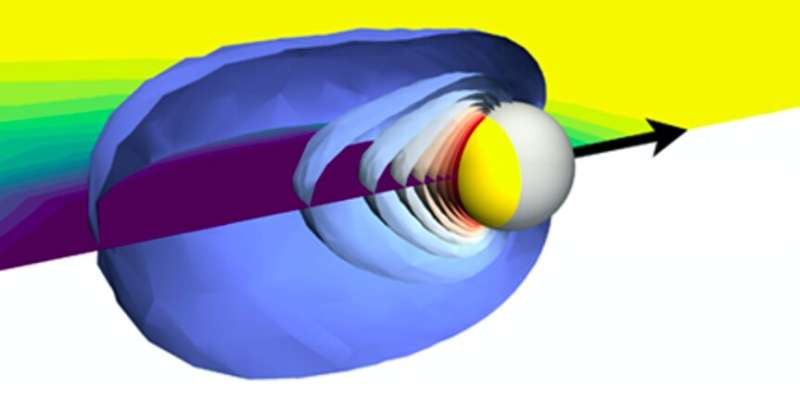Simulation results of a microscale Marangoni surfer straddling a liquid-liquid interface. The surfer has a golden cap, shown in yellow, that heats up due to laser light, which in turn induces “surfing” of the particle. The particle velocity is in the direction of the black arrow and can have a magnitude as high as 10'000 body-lengths per second. These incredible speeds are due to an intricate coupling between Marangoni stresses induced by both gradients of the temperature (depicted by the red to blue surfaces) and gradients of the surfactant concentration (depicted by the dark blue to yellow color of the interface). Credit: Nick Jaensson
Marangoni surfers are small particles that self-propel while straddling a fluid-fluid interface in a way similar to that in which a surfer moves on the surface of a wave. In recent years, self-propelling particles have become the focus of numerous physics studies, as they could serve as a model to study the motion of active Brownian objects with a broad range of velocities and interactions.
Researchers at ETH Zürich, Heinrich-Heine University in Düsseldorf and University College London (UCL) have recently realized active micrometric Marangoni surfers by applying laser light to Janus colloids absorbed at water-oil interfaces. Their paper, published in Physical Review Letters, builds on several previous studies exploring the use of light to control the motion of microswimmers.
"This work came about through a continued effort to realize microswimmers that are more efficient and that can be easily controlled," Lucio Isa and Nick Jaensson, two of the researchers who carried out the study, told Phys.org. "Our results are based on an existing body of work that deals with controlling the motion of microswimmers using light and with the properties of microswimmers confined at fluid interfaces, which includes some of our previous work."
In one of their previous studies, Isa and his colleagues found that confining Janus particles at oil-water interfaces allowed these particles to self-propel via self-generated chemical gradients that sparked catalytic reactions. This effect closely resembles the one often observed in particles inside bulk suspensions.
In addition, the researchers observed that these particles could interact very strongly with each other due to the repulsive electrostatic forces that characterize objects trapped in interfaces. While this observation opened up exciting new possibilities for the study of strongly interacting active particles, catalytic swimmers are known to be particularly difficult to control using external factors. This is because their propulsion depends on the concentration of chemical fuel, which is hard to dynamically regulate.
"The solution to this problem came by coupling the generation of asymmetric temperature gradients by light-absorbing Janus particles and the well-known idea that at fluid interfaces, those generate surface tension gradients and, correspondingly, Marangoni flows that could be harnessed to propel the particles via spatially and temporally controlled illumination," Isa and Jaensson said.
Marangoni surfers are self-propelling particles, which means that they can convert external sources of energy (e.g., light) into directed motion by creating and sustaining an asymmetry in the properties of their surrounding environment (e.g., temperature profiles), in turn generating surface tension profiles. The name Marangoni is associated with the origin of this self-propelling quality, which is mediated by surface tension gradients and their corresponding fluid flows. The manifestation of these fluid flows, which can be observed in several physical phenomena (e.g., tears of wine and propulsion of camphor boats), is known as the Marangoni effect.
"Marangoni surfers are important in physics because they constitute a new model system to study the active motion of self-propelling microscale objects with a huge dynamic range of velocities (up to 10,000 body lengths per second) and tunable interactions," Isa and Jaensson said. "The latter are mediated by the fluid interface, which also confines them in a two-dimensional plane without the presence of solid boundaries. Experimentally studying the collective motion of active particles in the absence of aggregation has been a challenge for the community and will pave the way to study two-dimensional materials such as crystals and glasses made exclusively of active components."
To realize microscale Marangoni surfers, Isa, Jaensson and their colleagues used a simple method that entails coating a particle monolayer (i.e., closely packed layer of particles) using a gold film via a technique known as sputter coating. Subsequently, they confined the particles at an oil-water interface by depositing a droplet of an aqueous suspension using a micro syringe.
Finally, the researchers illuminated the particles using a green laser. The light of this laser was absorbed by the particle's gold caps, generating an asymmetric temperature profile.
"The asymmetric temperature profile generated by the adsorption of the gold cap generates a surface tension gradient that propels the particles via Marangoni flows," Isa and Jaensson said. "In the presence of surface-active species, i.e., surfactants, the particle motion is also coupled to a concentration gradient, which generates a second surface tension profile. The balance between the two regulates propulsion."
Isa, Jaensson and their colleagues are among the first researchers to demonstrate active particles with an extremely wide range of possible propulsion velocities by harnessing Marangoni flows at the microscale. Moreover, the propulsion velocities of the particles they created can be easily regulated by simply controlling the surfactant concentration and illumination.
"The particles we demonstrated constitute a new model system that could be used to investigate the properties of a new class of active materials," Isa and Jaensson said. "We now plan to extend our studies, where we have essentially focused on characterizing the single-particle propulsion behavior and on elucidating its microscopic origins, to the case of the simultaneous control of assemblies of Marangoni surfers towards the realization of two-dimensional active materials."
More information: Kilian Dietrich et al. Microscale Marangoni Surfers, Physical Review Letters (2020). DOI: 10.1103/PhysRevLett.125.098001
Kilian Dietrich et al. Active Atoms and Interstitials in Two-Dimensional Colloidal Crystals, Physical Review Letters (2018). DOI: 10.1103/PhysRevLett.120.268004
Journal information: Physical Review Letters
© 2020 Science X Network
























